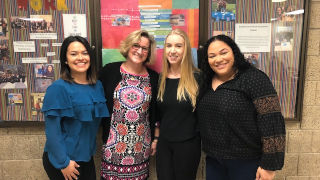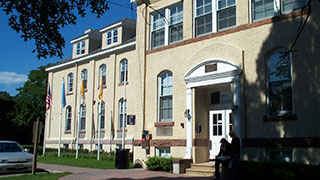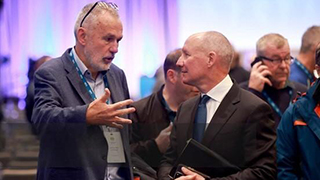Seton Hall Named a University Partner in Children's Bureau and Child Welfare Information Gateway Project - Seton Hall University
Saturday, February 16, 2019

Mary Landriau, Faculty Associate (second from L) with Senior B.S.W. students in BCWEP (L to R) – Yenny Masmela, Hudson West Local Office; Rachel Brooks, Union Central Local Office; and Marissa Barbosa, Monmouth Local Office
Seton Hall University is participating as a University Partner in a National Child Welfare Information project. The objective is to better understand how current and future professionals working in state and local child welfare agencies, tribes, and courts access information and use technology. The Children's Bureau invests in the development of free resources and services for new and seasoned child welfare agency and legal professionals every year. Unfortunately, many of these products, tools, and opportunities do not reach everyone who could use them, or they are not designed to best meet the needs and preferences of this constantly changing workforce.
How information is accessed and used is rapidly changing. Where to look for information and the types of resources that are most useful are likely changing too. The Child Welfare Information Gateway, funded by the Children's Bureau, reached out to the Seton Hall Bachelor of Arts in Social Work (B.S.W.) Program to better understand how professionals access information and use technology in their work and daily lives. Information will be gathered about the behaviors and preferences of current and future members of the child welfare workforce. The purpose is to improve the design and reach of resources and services for agency administrators, supervisors and caseworkers, judges and attorneys, and students so that they are more accessible, consumable, useful, and effective at helping child welfare systems to improve practice.
Faculty Associate, Mary Landriau, B.S.W. Field Director and Campus Coordinator for the Baccalaureate Child Welfare Education Program (BCWEP) is the liaison for this work and students will gather information aimed at answering the following questions:
- How do child welfare agency and legal professionals currently get information that they use in their jobs?
- How do professionals determine what information is most trustworthy?
- What makes professionals more likely to use new technologies (such as software, devices, and social media) to consume information, and what types of information are they most likely to access through those technologies?
- In what ways do professionals' information habits and preferences vary based on their characteristics, the type of organization in which they work, their role, or their service areas?
- In what ways have professionals' information habits changed in recent years, and how do they expect them to change in the future?






